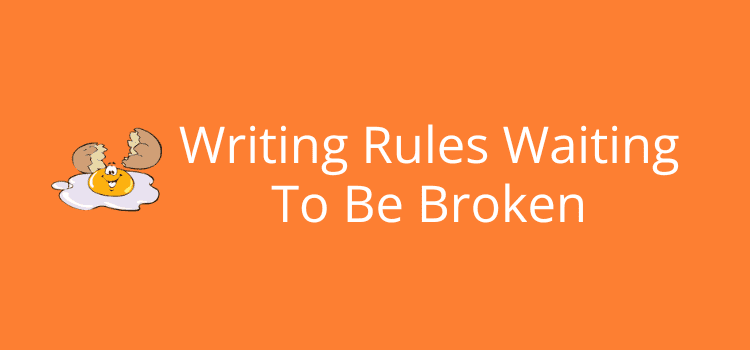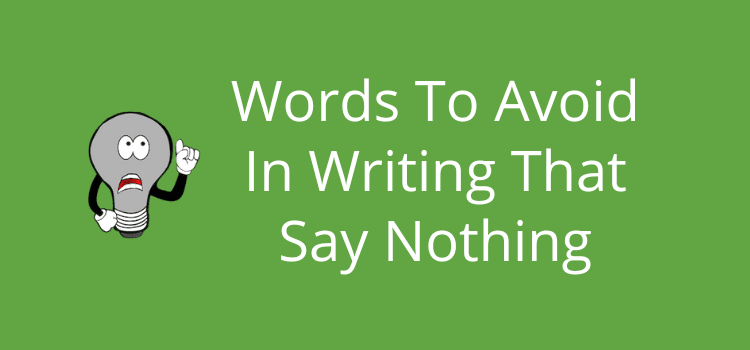
You’ve probably read hundreds of advice articles about grammar and writing rules. Hopefully, a few might have even been ones I wrote.
While knowing the rules is always good, that doesn’t mean they are set in concrete.
General rules are a good guide for correct grammar usage and effective writing. But they are not laws, so you won’t be punished for breaking some of them.
Bending, tweaking, and breaking the rules is, in fact, a sign of a skilled writer.
When to break the rules
I’m sure you know the saying that you need to know the rules before you can break them.
It’s true, because the signs of an inexperienced writer are mistakes made out of a lack of understanding or knowledge.
Errors might include irregular punctuation, grammar mistakes, or poor or repetitive vocabulary.
Style and tone can also be a problem. The writing can seem flat if there is little variation in sentence structures.
However, good writers make deliberate choices to bend or break the rules. (The history of English rules is full of changes and modifications.)
Very often, it is to change the pace or tone of their writing.
It might be intentionally using a sentence fragment to give a point more emphasis or even to create a sense of urgency.
Writing great dialogue is always about knowing and breaking the rules to make characters more realistic.
It’s all about choice. But you can only choose if you know the options.
The difference, in the end, is that excellent writers break the rules on purpose, while inexperienced writers do so accidentally.
10 Writing rules ripe for breaking
I could have made this a much longer list, but I’ve kept it to what I believe are the ones that are prime for the task. All of the following rules are excellent advice and, in most cases, are usually the best option.
However, in some circumstances, tweaking, twisting, or outright breaking them is a good move. But only sometimes, and only for a good reason.
1. Starting a sentence with and, but or so
What is the rule?
Sentences should not begin with conjunctions.
When to break the rule
To create a more conversational or informal tone. Starting a sentence with and or but creates simple continuity or contrast, making it easy to read.
Examples
The project was due yesterday. And yet, we still haven’t started.
She wasn’t sure if she wanted to go. But when she heard the name of the band, she changed her mind.
It was getting late. So, we decided to head home.
This works well in creative writing, personal essays, or informal content where you want a more relaxed tone.
When to follow the rule
In formal, academic, or professional writing, sticking to this rule will result in a more classic and structured text.
Example
The project was due yesterday. However, we have not yet started.
2. Avoid sentence fragments
What is the rule?
Sentence fragments are incomplete sentences lacking a main clause. They are often missing a subject, verb, or both, which is grammatically incorrect.
When to break the rule
By breaking this rule, you can add emphasis, create rhythm, or recreate natural speech.
Sentence fragments are particularly effective in creative writing and dialogue.
Examples
She saw the car. Parked in the driveway. Unlocked the door. And walked inside.
The news was shocking. Absolutely unbelievable.
Fragments are useful to show a character’s fragmented thoughts or to create intentional pauses.
When to follow the rule
For scientific research writing, academic papers, or professional documents, complete sentences are preferred to maintain clarity and coherence.
3. Don’t use the passive voice
What is the rule?
The active voice says who (the subject) did what (a verb), which is clear and more descriptive. The passive voice, in contrast, is when the subject of a sentence receives the action rather than doing it.
When to break the rule:
Using passive voice is effective in creative writing when you want to create a sense of mystery, focus on the action, or when the actor is unknown or unimportant.
Examples
The murder weapon had been placed neatly beside the body, yet no fingerprints were found. (Focusing on the weapon while the identity of the killer remains unknown.)
Dinner had been served, but one place remained empty at the table. (Hints at something ominous, focusing on the absence without revealing who is missing or why.)
Passive voice is useful for creating a mood or atmosphere, such as slowly revealing plot details or when the actor is irrelevant to the scene or yet to be identified.
When to follow the rule
In most forms of creative writing, active voice is almost always more engaging and vivid, as it brings the reader directly into the action.
Active voice helps you keep scenes dynamic and your characters front and center.
Example
She found the hidden key under the loose floorboard. (Active voice makes the action and character’s role more immediate and clear.)
4. Avoid clichés
What is the rule?
Clichés are phrases or expressions that are overly familiar or predictable due to overuse, such as, light at the end of the tunnel, or, a needle in a haystack.
Traditional writing advice is to avoid clichés because they can make your work seem stale or unoriginal.
When to break the rule
Clichés are sometimes caused by lazy writing. But there are times when using them can serve a genuine purpose.
In dialogue especially, a character who uses clichés can reveal something about their personality or background.
Examples
You know what they say, when life gives you lemons…
It was the calm before the storm. And then, well, nothing happened.
When to follow the rule
In most cases, you should avoid clichés because they can make your work feel predictable or uninspired.
Instead of resorting to tired phrases, push yourself to come up with fresh and new descriptions that give readers a better perspective.
5. Don’t overuse adverbs
What is the rule?
The general rule is to avoid adverbs, especially those that end in -ly.
The rule is that strong verbs should stand on their own and that adverbs can weaken your writing by making it overly descriptive or redundant.
When to break the rule
Let’s get one thing straight. Adverbs aren’t all or always bad.
In some instances, an adverb can help convey emotion or detail that a verb can’t do by itself.
Examples
She whispered softly into the night. (The adverb “softly” adds a layer of intimacy to the action.)
He ran clumsily down the hill. (Here, the adverb clumsily explains how the character ran, adding extra detail to the action.)
Adverbs can also be useful in dialogue to capture how something is said, like angrily or nervously, if you want to specify a tone quickly without resorting to long descriptions.
When to follow the rule
Relying on adverbs too much can lead to lazy writing.
Strong, specific verbs usually deliver more meaning than a verb-adverb combination.
6. Don’t split the infinitive
What is the rule?
The infinitive is the base form of a verb, preceded by to, such as to run or to eat.
The rule is that you should never split infinitives by placing a word between to and the verb.
When to break the rule
Since Star Trek decided to boldly go, this rule has struggled to stay relevant.
In creative writing, splitting an infinitive can add emphasis, rhythm, or a more natural, conversational tone.
Examples
She decided to carefully consider the offer. (Here, the adverb carefully highlights the thoughtfulness of her decision better than to consider carefully.)
He vowed to never give up. (It would be less emphatic to write, he vowed never to give up.)
When to follow the rule
In formal writing or academic contexts, splitting infinitives can still be seen as a grammatical mistake.
Sticking to the rule can help maintain a polished tone in cases where clarity and professionalism are essential.
7. Don’t end sentences with prepositions
What is the rule?
This rule is that you shouldn’t end sentences with prepositions words like with, at, to, and for.
Instead, the preposition should be followed by an object or noun.
For example, instead of saying, this is the problem I can’t deal with, the rule changes the sentence to, this is the problem with which I cannot deal.
When to break the rule
In most forms of writing, ending a sentence with a preposition is more natural. Trying to avoid prepositions at the end of a sentence can lead to awkward or overly formal phrasing.
Examples
What are you waiting for? is much more natural than, for what are you waiting?
That’s the house I grew up in, sounds more conversational and relatable than, that’s the house in which I grew up.
In dialogue or first-person narration, breaking this rule makes your writing flow better and read more like how people speak.
When to follow the rule
Generally, only in formal writing—primarily academic, legal, or technical texts.
Avoiding prepositions at the end of a sentence helps uphold a more formal structure.
Example
This is the policy to which we must adhere, sounds more professional than, this is the policy we must adhere to.
In these cases, following the rule maintains clarity and professionalism, which is essential in some formal contexts.
8. Avoid comma splices
What is the rule?
A comma splice error happens when two independent clauses are joined together by a comma without an appropriate conjunction or punctuation mark.
For example, I went to the store, it was closed.
The rule says that this error must corrected using a period (full stop), semicolon, or conjunction to separate the clauses.
I went to the store. It was closed.
When to break the rule
Comma splices are effective in creative writing when you want to create a rhythm or pace.
They can mimic the flow of a character’s thoughts or add urgency to a scene.
Examples
She ran down the street, the rain was coming down hard, her heart was pounding. (The comma splices convey a sense of rapid, continuous action.)
He looked at her, she looked away, the silence was unbearable. (This structure adds a feeling of tension and immediacy.)
In dialogue or stream-of-consciousness writing, comma splices allow you to show how your characters speak or think. Good grammar isn’t always the best way to do this.
When to follow the rule
In many cases, especially in formal or clear narrative writing, comma splices can confuse readers or disrupt the flow.
I went to the store, but it was closed. (Here, using a conjunction improves the sentence’s flow and clarity.)
In structured writing, eliminating comma splices helps you make sure that you communicate your ideas clearly.
9. Never use double negatives
What is the rule?
A double negative is when two negative words are used in the same sentence.
It can create confusion or result in an unintended positive meaning.
For example, I don’t have no money” technically means, I have money.
The rule is that you should avoid double negatives to keep your writing clear and precise.
When to break the rule
Double negatives can be useful in dialogue or when you want to set a specific tone or voice, especially in informal speech.
Examples
A character might use a double negative to reflect their regional accent or personality:
I ain’t got nothing to say to you. (This gives the character a more casual or colloquial feel.)
He don’t know nothing about it. (Adds authenticity to the voice, especially in informal dialogue.)
But even in more standard sentences, double negatives can be useful, or even unavoidable.
My manager’s refusal was not unexpected.
In creative writing, double negatives can give a sense of reality or show a character’s personality, making their speech more natural.
When to follow the rule
In formal or professional writing, double negatives should be avoided.
Clear and direct language is always best in these contexts.
10. Follow the grammar rules
What is the rule?
Grammar rules give structure and clarity in writing. They cover everything from punctuation and sentence structure to the proper use of tenses and subject-verb agreement.
When to break the rule
In creative writing, when you ignore some grammar rules, you can make your writing more natural, conversational, or reflect a character’s specific voice.
Examples
Can’t stop thinking about it. The way it happened. You know, so fast. So sudden.
I dunno what happened, but it ain’t good. (Using informal grammar to make a character’s speech more realistic.)
Intentional rule-breaking can bring a more personal or raw feeling to your writing.
When to follow the rule
Breaking grammar rules can hinder readability or make things confusing.
Even in creative writing, using proper grammar can still keep a story flowing smoothly.
Example
He walked to the edge of the cliff and stared down at the jagged rocks below. (Here, good grammar allows the imagery to shine without distractions.)
Summary
There are lots of writing and grammar rules, and they are there for good reason. They help us write clearly and effectively.
But in creative writing, knowing when and why to break the rules opens up lots of opportunities.
It’s a balance between structure and freedom.
Follow the rules when they are necessary, but bend or break them when it allows you to add depth, character, or style.
The critical factor is to be intentional when making your choices.
When you break the rules, it’s for a purpose or impact, not by accident.
Related Reading: 10 Writing Myths Every New Writer Can Ignore
Share This Article


